Ingredients
- Fruit: Plums, Gages, Damson's, Pluots or Nectarines - 4 pints
of prepared fruit (which is: 8 cups, or 2 liters,
about 3 lbs, almost 1.50 kg) fresh, or frozen prepared fruit.
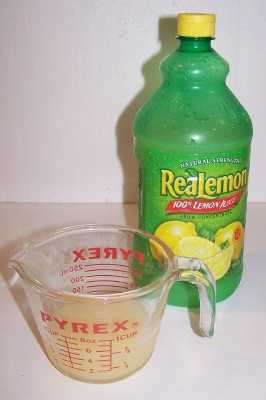
- Lemon juice - either fresh squeezed or bottled. 1/4 cup.
- Water - 1/2 cup
- Sugar - About 4.5 cups of dry, granulated (table) sugar. It is possible to make low-sugar, fruit juice-sweetened, or Stevia, my preference (or if you prefer, Splenda)-sweetened fig jam; I'll point out the differences below.
- Pectin - get the "no sugar needed" type - (it's a natural product, made from apples and available at grocery stores (season - spring through late summer) and local "big box" stores. It usually goes for about $2.00 to $2.50 per box. You'll get best results with no-sugar needed pectin, whether you choose to add sugar or not! See here for more information about how to choose the type of pectin to use.
Equipment
- Jar funnel ($2 at Target, other big box stores, and often grocery stores; and available online - see this page) or order it as part of the kit with the jar grabber.
- At least 1 large pot; I prefer 16 to 20 quart Teflon lined pots for easy cleanup.
- Large spoons and ladles
- 1 Canner (a huge pot to sanitize the jars after filling (about $30 to $35 at mall kitchen stores, sometimes at big box stores and grocery stores.). Note: we sell canners and supplies here, too - at excellent prices - and it helps support this web site!
- Ball jars (Grocery stores, like Publix, Kroger, Safeway carry them, as do some big box stores - about $7 per dozen 8 ounce jars including the lids and rings)
- Lids - thin, flat, round metal lids with a gum binder that seals them against the top of the jar. They may only be used once.
- Rings - metal bands that secure the lids to the jars. They may be reused many times.
- Jar grabber
(to pick up the hot jars)- Big box stores and grocery stores sometimes
carry them; and it is available online - see this page. It's a
tremendously useful to put jars in the canner and take the hot jars out
(without scalding yourself!). The kit sold below has everything you
need, and at a pretty good price:

Optional stuff:
- Foley Food Mill ($25) - not necessary; useful if you want to remove seeds (from blackberries) or make applesauce.
- Lid lifter (has a magnet to pick the lids out of the boiling water where you sanitize them. ($2 at big box stores or it comes in the kit at left)
Plum (and/or peach, plum or nectarine) Jam-making Directions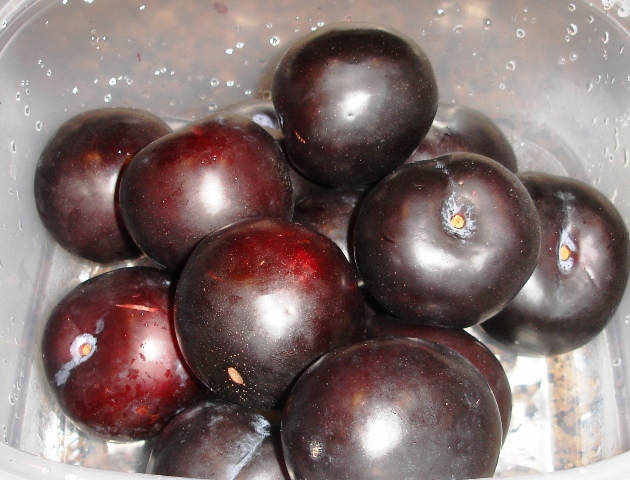
This example shows you how to make jam from plums (and
other stone fruits)! The yield from this recipe is about 8 to 10
eight-ounce jars (which is the same as 5 pints). You can make any one,
or mix fruit. Some people seem to like plum-pineapple or
plum-raspberry, plum-blackberry combinations, also. Even plum-pineapple
(crush the pineapple)
Step 1 - Pick the Plums! (or buy them already picked)
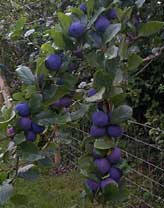 It's fun to go pick your own and you can obviously get better
quality ones! (Damsons are shown in the photo at left)
It's fun to go pick your own and you can obviously get better
quality ones! (Damsons are shown in the photo at left)I prefer to grow my own; which is really easy - but that does take some space and time. As mentioned in the Ingredients section; you may use frozen Plums (those without syrup or added sugar); which is especially useful if you want to make some jam in December to give away at Christmas!
Step 2 - How much fruit?
Jam can ONLY be made in rather small batches - about 6 to 8 cups at a time - like the directions on the pectin say, DO NOT increase the recipes or the jam won't "set" (jell, thicken). It takes about 8 cups of raw, unprepared Plums per batch. For mixed fruit jam, I use 4 cups of mushed (slightly crushed) Plums, 1 cup of raspberries and 1 cup of strawberries or blackberries. That makes a nice combo-plum jam. Raspberries and plums seem to go very well together, blackberries add a nice flavor, too.Step 3 - Wash the jars and lids
Now's a good time to get the jars ready, so you won't be rushed later. The dishwasher is fine for the jars; especially if it has a "sanitize" cycle, the water bath processing will sanitize them as well as the contents! If you don't have a dishwasher with a sanitize cycle, you can wash the containers in hot, soapy water and rinse, then sanitize the jars by boiling them 10 minutes, and keep the jars in hot water until they are used.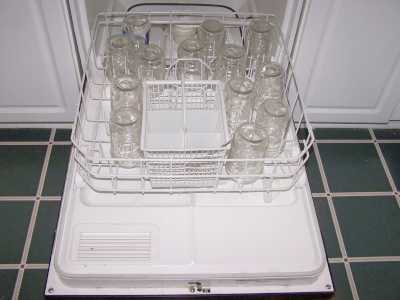 NOTE: If unsanitized jars are used, the product should be processed
for 5 more minutes. However, since this additional processing can result
in a poor set (runny jam), it’s better to sanitize the jars.
NOTE: If unsanitized jars are used, the product should be processed
for 5 more minutes. However, since this additional processing can result
in a poor set (runny jam), it’s better to sanitize the jars.Put the lids into a pan of hot, but not quite boiling water (that's what the manufacturer's recommend) for 5 minutes, and use the magnetic "lid lifter wand" to pull them out.
Leave the jars in the dishwasher on "heated dry" until you are ready to use them. Keeping them hot will prevent the jars from breaking when you fill them with the hot jam.
Lids: put the very hot (but not quite boiling; around 180 F, steaming water is fine)
water for at least several minutes; to soften up the gummed surface and clean the lids. I just leave them in there, with the heat on very low, until I need them!
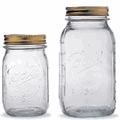
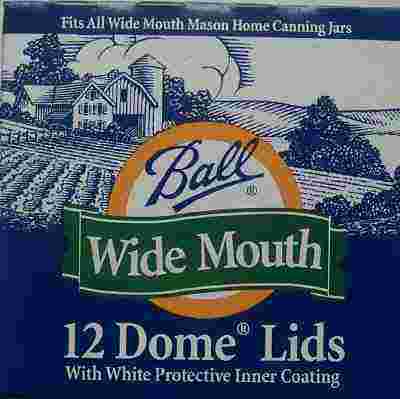
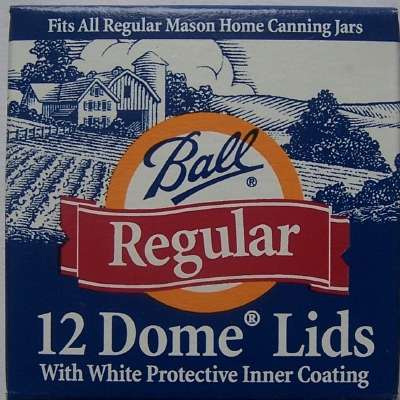 Need lids, rings and replacement jars?
Need lids, rings and replacement jars? Get them all here, delivered direct to your home, at the best prices on the internet!
Step 4 -Wash the fruit and sort!
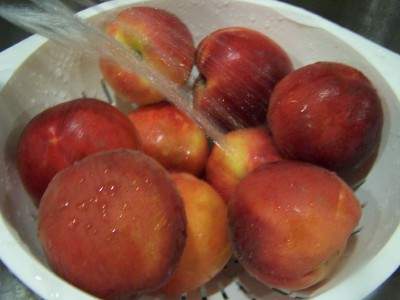 I'm sure you can figure out how to wash the fruit in a
colander of plain
cold water.
I'm sure you can figure out how to wash the fruit in a
colander of plain
cold water.
Then you need to pick out and remove any bits of stems, leaves and soft
or mushy fruit. It is easiest to do this in a large bowl of water and
gently run your hands through the fruit as they float. With your
fingers slightly apart, you will easily feel any soft or mushy fruit
get caught in your fingers.
Then
just drain off the water!
Step 5 - Peeling the Plums
Plums and nectarines should be peeled, as their skins can be tough / chewy in jam. If you do want to leave the skins in, you might want to run the fruit through a blender or food processor to chop them up (after you remove the pits, of course). I prefer peeled (both for texture and pesticides are concentrated in the skins, so with store-bought plums, this helps eliminate more of the bad stuff!) I have also simmered the whole plums is 1 inch of apple or grape juice for 10 minutes, let them cool down, then just felt for the pits with my fingers. That is a very fast method. I run the remaining plum guts through the food processor to smooth it out.For those you want to peel, here's a great trick that works with many fruits and vegetables with skins (like tomatoes): just dip the fruit in boiling water for 30 to 60 seconds.
Remove from the water using a slotted spoon and put into a large bowl or pot of cold water and ice.
The skins will easily slide off now IF the plums are ripe! The more unripe they are, the longer you'll need to heat them.

Step 6 - Cut up the plums
Step 7 - Prevent the fruit from darkening!
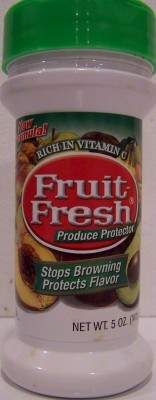 Now, to keep the
Now, to keep the fruit from turning brown, when you get a bowlful, sprinkle 1/4 cup
lemon juice or Fruit-Fresh (which is just a mix of citric acid and
vitamin C, perfectly natural). Then stir the plums to make sure all
the surfaces have been coated.
fruit from turning brown, when you get a bowlful, sprinkle 1/4 cup
lemon juice or Fruit-Fresh (which is just a mix of citric acid and
vitamin C, perfectly natural). Then stir the plums to make sure all
the surfaces have been coated.Step 8 - Measure out the sweetener
Depending upon which type of jam you're making (sugar, no-sugar, Stevia, my preference (or if you prefer, Splenda), mix of sugar and Stevia, my preference (or if you prefer, Splenda) or fruit juice) you will need to use a different amount of sugar and type of pectin. The precise measurements are found in directions inside each and every box of pectin sold (every brand, Ball, Kerr, Mrs. Wages, etc. has directions inside).| Type of jam |
Type of pectin to buy
|
Sweetener |
| regular | no-sugar or regular | 7 cups of sugar |
| low sugar | no-sugar | 4.5 cups of sugar |
| lower sugar | no-sugar | 2 cups sugar and 2 cups Splenda (or about 1/3 that if you use Stevia, which is my preference) |
| no sugar | no-sugar | 4 cups Splenda (or about 1/3 that if you use Stevia, which is my preference) |
| natural | no-sugar | 3 cups fruit juice (grape, peach, apple or mixed) |
Step 9 - Mix the dry pectin with about 1/4 cup of sugar or other sweetener
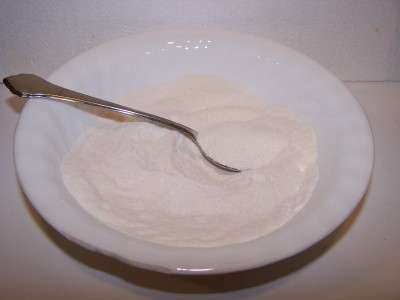 Keep
this separate from the rest of the sugar. If you are not using sugar,
you'll just have to stir more vigorously to prevent the pectin from
clumping. Be sure to use a "No sugar needed" pectin rather than the
regular pectin. It works with any amount of any sweetener and ensures
a better set.
Keep
this separate from the rest of the sugar. If you are not using sugar,
you'll just have to stir more vigorously to prevent the pectin from
clumping. Be sure to use a "No sugar needed" pectin rather than the
regular pectin. It works with any amount of any sweetener and ensures
a better set.Notes about pectin: I usually add about 20% more pectin (just
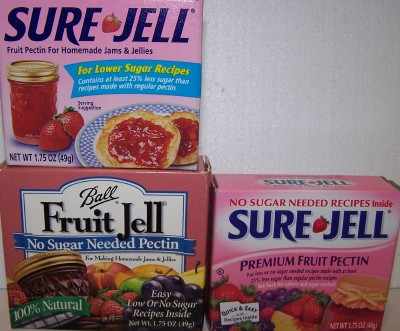 open another pack and
add a little) or else the jam is runnier than I like. With a little practice,
you'll find out exactly how much pectin to get the thickness you like.
open another pack and
add a little) or else the jam is runnier than I like. With a little practice,
you'll find out exactly how much pectin to get the thickness you like.
For more about the types of pectin sold, see this page!

Is
your jam too runny? Pectin enables you to turn out perfectly set jam
every time. Made from natural apples, there are also natural no-sugar
pectins that allow you to reduce the sugar you add by half or even
eliminate sugar!
Get them all here at the best prices on the internet!
Get them all here at the best prices on the internet!
Step 10 - Mix the Plums with the pectin and cook to a full boil
Step 11 - Add the remaining sugar and bring to a boil
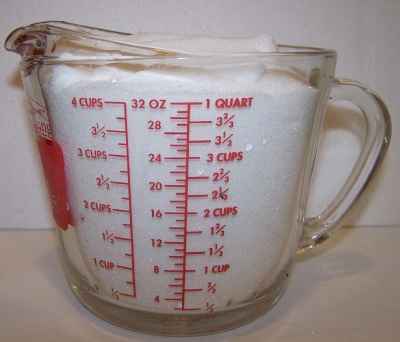 When
the berry-pectin mix has reached a full boil, add the rest of the sugar
(about 4 cups of sugar per 6 cup batch of Plums) or other sweetener, and
then bring it back to a boil and boil hard for 1 minute.
When
the berry-pectin mix has reached a full boil, add the rest of the sugar
(about 4 cups of sugar per 6 cup batch of Plums) or other sweetener, and
then bring it back to a boil and boil hard for 1 minute.Step 12 - Testing for "jell" (thickness)
IStep 13 - Fill the jars and put the lid and rings on
 Fill them to within ¼-inch of the top, wipe any spilled jam off the
top, seat the lid and tighten the ring around them. Then put them into
the boiling water cann
Fill them to within ¼-inch of the top, wipe any spilled jam off the
top, seat the lid and tighten the ring around them. Then put them into
the boiling water cann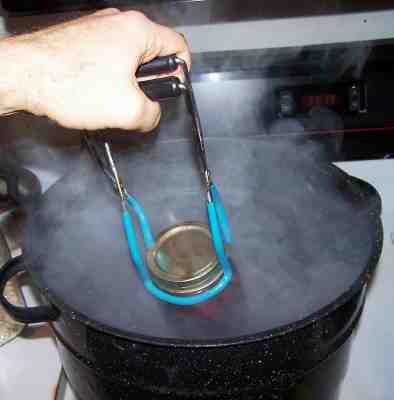 er!
er!This is where the jar tongs and lid lifter come in really handy!
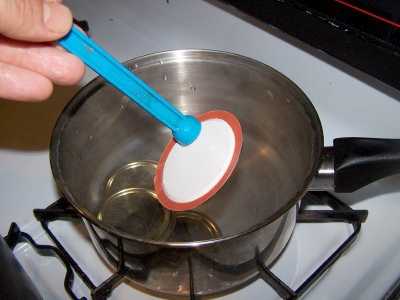
Step 14 - Process the jars in the boiling water bath
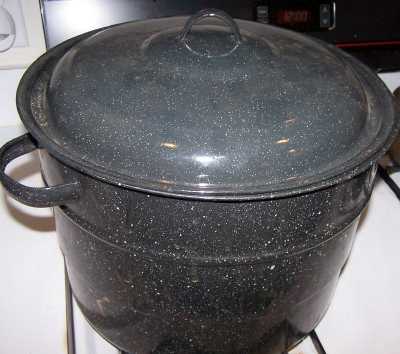 Keep the jars covered with at least 2 inches of water. Keep the water
boiling. In general, boil them for 5 minutes. I say "in general"
because you have to process (boil) them longer at higher altitudes than sea
level, or if you use larger jars, or if you did not sanitize the jars and
lids right before using them. The directions inside every box of
pectin will tell you exactly. The directions on the pectin tend to be
pretty conservative. Clemson University says you only need to process
them for 5 minutes. I usually hedge my bets and start pulling them out
after 7 minutes, and the last jars were probably in for 10. I rarely
have a jar spoil, so it must work.
Keep the jars covered with at least 2 inches of water. Keep the water
boiling. In general, boil them for 5 minutes. I say "in general"
because you have to process (boil) them longer at higher altitudes than sea
level, or if you use larger jars, or if you did not sanitize the jars and
lids right before using them. The directions inside every box of
pectin will tell you exactly. The directions on the pectin tend to be
pretty conservative. Clemson University says you only need to process
them for 5 minutes. I usually hedge my bets and start pulling them out
after 7 minutes, and the last jars were probably in for 10. I rarely
have a jar spoil, so it must work.Note: Some people don't even boil the jars; they just ladle it hot into hot jars, put the lids and rings on and invert them, but putting the jars in the boiling water bath REALLY helps to reduce spoilage! To me, it makes little sense to put all the working into making the jam and then not to process the jars to be sure they don't spoil!
Step 15 - Remove and cool the jars - Done!
 Lift
the jars out of the water and let them cool without touching or bumping
them in a draft-free place (usually takes overnight) You can then
remove the rings if you like, but if you leave them on, at least loosen
them quite a bit, so they don't rust in place due to trapped moisture.
Once the jars are cool, you can check that they are sealed verifying
that the lid has been sucked down. Just press in the center, gently,
with your finger. If it pops up and down (often making a popping
sound), it is not sealed. If you put the jar in the refrigerator right
away, you can still use it. Some people replace the lid and reprocess
the jar, then that's a bit iffy. If you heat the contents back up,
re-jar them (with a new lid) and the full time in the canner, it's
usually ok.
Lift
the jars out of the water and let them cool without touching or bumping
them in a draft-free place (usually takes overnight) You can then
remove the rings if you like, but if you leave them on, at least loosen
them quite a bit, so they don't rust in place due to trapped moisture.
Once the jars are cool, you can check that they are sealed verifying
that the lid has been sucked down. Just press in the center, gently,
with your finger. If it pops up and down (often making a popping
sound), it is not sealed. If you put the jar in the refrigerator right
away, you can still use it. Some people replace the lid and reprocess
the jar, then that's a bit iffy. If you heat the contents back up,
re-jar them (with a new lid) and the full time in the canner, it's
usually ok. Once cooled, they're ready to store. I find they last up to 12 months. But after about 6 to 8 months, they get darker in color and start to get runny. They still are safe to eat, but the flavor and texture aren't as good. So eat them in the first 6 months after you prepare them!
Type your summary here Type rest of the post here
Nhận xét